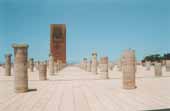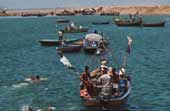 About Our Trip About Our Trip
First we’ll start off with a 4 nights stay in Rabat.
We’ll be accommodated in a charming guesthouse neighbouring the old princesses for the length of our stay.
During our visit we will see Le Tour Hassan and the Mausoleum of Mohammed V. We’ll have a walk through the medina and the Kashbah des Oudais. A must see is the Palace Royal and the necropolis of Chellah, the remains of an ancient roman city of Sala Colonia, which is also on the program.
We'll spend a day at the beach and at last we’ll be going to a local Hammam which will be a typical Moroccan experience in itself.
 About Rabat About Rabat
Pirate stronghold, breakaway republic, Imperial City and today's capital, Rabat has worn many cloaks during its 700 year history.
Poised above the Atlantic rollers is the Oudaia Kasbah, Rabat's evocative citadel, like a spider at the heart of a 5km web of ramparts. The fourth of the imperial cities, Rabat is a curious mix of a long past and a highly modernised present. The city's glory days were in the 12th century, when the then sultan used the Kasbah as a base for campaigns against the Spanish. It was during this time that the city's most famous landmarks sprang up. A haven for Muslims driven out of Spain in the early 17th century and a capital city only since the days of French occupation, Rabat's ambience comes from Islam and Europe in fairly equal proportions. For every place of worship there are three or four European-style cafes.
Few of Rabat's residents are involved in the tourist racket, which means you can stroll through the markets without having to brace yourself against too much high-pressure salesmanship.
The city's most famous site is the Tour Hassan, the incomplete minaret of the great mosque begun by Yacoub al-Mansour. An earthquake brought construction to a halt in 1755. Alongside is the Mausoleum of Mohammed V, one of Rabat’s important landmarks.
The Kasbah des Oudaias, built on the bluff overlooking the Atlantic Ocean, houses a former palace, which is now a museum of traditional art.
Beyond the city walls are the remains of the ancient city of Sala. Also known as Chella, it has Morocco's best Archaeology Museum.
There are excellent beaches both to the north and south of the city. |



